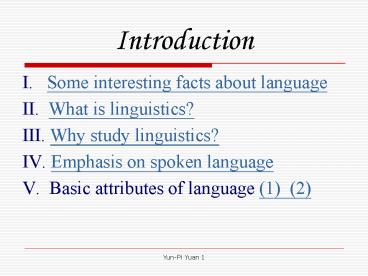I. Some interesting facts about language - PowerPoint PPT Presentation
Title:
I. Some interesting facts about language
Description:
Ten most widely spoken languages: (based on info. from www.sil. ... 1. Phonology (Phonetics & Phonemics) 2. Syntax (Morphology & Grammar) 3. Semantics (Meaning) ... – PowerPoint PPT presentation
Number of Views:511
Avg rating:3.0/5.0
Title: I. Some interesting facts about language
1
Introduction
- I. Some interesting facts about language
- II. What is linguistics?
- III. Why study linguistics?
- IV. Emphasis on spoken language
- V. Basic attributes of language (1) (2)
2
Some Interesting Facts About Language
- Number of languages about 6,809 languages in the
world (or about 4,000 8000 languages? because
its hard to define what counts as a language),
about 50 of theses are dying out - Ten most widely spoken languages (based on info.
from www.sil.org in Sept. 2000.) - 1. Mandarin Chinese 2. Spanish 3. English 4.
Bengali 5. Hindi/Urdu 6. Portuguese 7.
Russian 8. Japanese 9. German 10.
Chinese-Wu
3
Ten Most Widely Spoken Languages
- According to David Crystal The Cambridge
Encyclopedia of Language (1987, p. 287)mother
tongue speakers - 1. Chinese (Mandarin) 2. English 3. Spanish 4.
Hindi 5. Arabic 6. Bengali 7. Russian 8.
Portuguese 9. Japanese 10. German
4
Reasons for the Uncertainty over Numbers of
language (1)
- New discoveries new people (and therefore
languages) continue to be discovered in the
unexplored regions of the world (esp. in the
Amazon basin, Central Africa, and New Guinea). - Alive or dead language?
- Political decisions
- Economic reason
- Diseases
- others
5
Reasons for the Uncertainty over Numbers of
language (2)
- Language or dialect?
- Five types of relationship between dialect and
language - Type 1
- community A
community B - e.g. British Eng. same language American
Eng.
Mutually intelligible common cultural history
6
Reasons for the Uncertainty over Numbers of
language (3)
- Type 2
- community A community B
- e.g. English different languages Hindi
- Type 3
- community A community B
- e.g. Norwegian ? Danish
Mutually unintelligible different cultural
history
Mutually intelligible different cultural history
7
Reasons for the Uncertainty over Numbers of
language (4)
- Type 4
- community A
community B - e.g. Cantonese
Hakka - (Chinese) ? (Chinese)
- Type 5
- Community A community B
- e.g. Turkish ? Uzbek
Mutually unintelligible same cultural history
Partially (un)intelligible overlapping cultural
history
8
Reasons for the Uncertainty over Numbers of
language (5)
- Language names
- Many communities have no specific name for their
language (especially in Africa and South
America). e.g. Bantu, refers to a whole family of
languages, and means simply people. - Or a community whose language has too many names
- Or same name is applied to two different
languages (e.g., Mexicano used in Mexico to refer
to Spanish and to the main Indian language
Nahuatl).
9
What Is Linguistics?
- Definition
- the systematic scientific study of language
- Purpose to learn the different aspects of
language - How it is structured how we produce understand
it in ongoing time how we learn it how it
developed in humans how we use it every day
what we use it for how it works in our minds and
in society. - Study range of linguistics
- 1. Phonology (Phonetics Phonemics)
- 2. Syntax (Morphology Grammar)
- 3. Semantics (Meaning)
- 4. Pragmatics (the interpretation in context)
10
Why Study Linguistics? (1)
- To improve your English through study of subject
in English - Exploiting a languages total resources to create
literature - To learn something about psychology
- Lang. is very important to everything you do.
- To examine your own belief about lang. in
general, lang. in particular, and especially,
speakers. - To learn to observe analyze
11
Why Study Linguistics? (2)
- More reasons . . .
- Might keep you out of prison
- To improve language teaching learning
- Language rights
- Technology
12
Emphasis on Spoken Language
- Speech primary
- History
- individual
- Writing is not always present.
- Change reflected slowly in writing
- Similar writing system can be used for very
different languages, or more than one system for
one language.
13
Basic Attributes of Language (1)
- Unique properties
- Language is random (and not so random). (Nash
45) - Arbitrariness (Yule 2122)
- Displacement (Yule 2021)
- Language is a body of (very productive and
creative) knowledge. (Nash 3) - Productivity (creativity or
open-endedness) (Yule 2223) - Language is social and cultural. (Nash 56)
- Cultural transmission (Yule 24)
- Language has a series of levels, governed by
rules. (Nash 34) - Duality (or double articulation) (Yule
25) - Discreteness (Yule 24)
14
Duality (or Double Articulation)
- A series of levels
- Sounds, no meaning
- Sound meaning
- Sentence structure
- Discourse
- Duality
- Sound
- Meaning
15
Basic Attributes of Language (2)
- Language uses sounds (Nash) Vocal-auditory
channel (Yule) - Reciprocity (Yule)
- Specialization (Yule)
- Non-directionality (Yule)
- Rapid fade (Yule)
- Language is communication (Nash)
- Language is human (Nash)
- Language is a system (Nash)
- Languages are more similar than they are
different (Nash) - Language changes (Nash)
- Language is accompanied by gestures (Nash)

